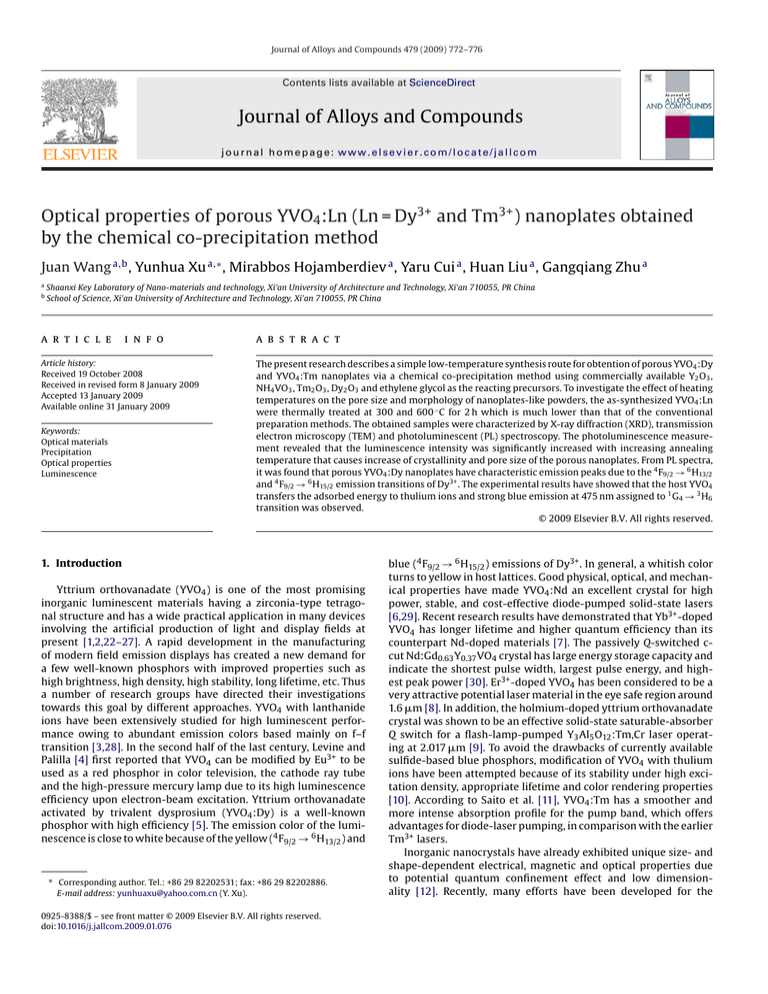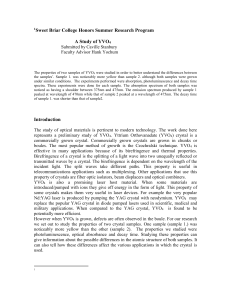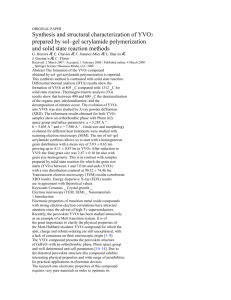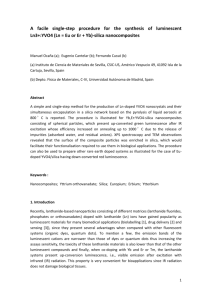
Journal of Alloys and Compounds 479 (2009) 772–776
Contents lists available at ScienceDirect
Journal of Alloys and Compounds
journal homepage: www.elsevier.com/locate/jallcom
Optical properties of porous YVO4 :Ln (Ln = Dy3+ and Tm3+ ) nanoplates obtained
by the chemical co-precipitation method
Juan Wang a,b , Yunhua Xu a,∗ , Mirabbos Hojamberdiev a , Yaru Cui a , Huan Liu a , Gangqiang Zhu a
a
b
Shaanxi Key Laboratory of Nano-materials and technology, Xi’an University of Architecture and Technology, Xi’an 710055, PR China
School of Science, Xi’an University of Architecture and Technology, Xi’an 710055, PR China
a r t i c l e
i n f o
Article history:
Received 19 October 2008
Received in revised form 8 January 2009
Accepted 13 January 2009
Available online 31 January 2009
Keywords:
Optical materials
Precipitation
Optical properties
Luminescence
a b s t r a c t
The present research describes a simple low-temperature synthesis route for obtention of porous YVO4 :Dy
and YVO4 :Tm nanoplates via a chemical co-precipitation method using commercially available Y2 O3 ,
NH4 VO3 , Tm2 O3 , Dy2 O3 and ethylene glycol as the reacting precursors. To investigate the effect of heating
temperatures on the pore size and morphology of nanoplates-like powders, the as-synthesized YVO4 :Ln
were thermally treated at 300 and 600 ◦ C for 2 h which is much lower than that of the conventional
preparation methods. The obtained samples were characterized by X-ray diffraction (XRD), transmission
electron microscopy (TEM) and photoluminescent (PL) spectroscopy. The photoluminescence measurement revealed that the luminescence intensity was significantly increased with increasing annealing
temperature that causes increase of crystallinity and pore size of the porous nanoplates. From PL spectra,
it was found that porous YVO4 :Dy nanoplates have characteristic emission peaks due to the 4 F9/2 → 6 H13/2
and 4 F9/2 → 6 H15/2 emission transitions of Dy3+ . The experimental results have showed that the host YVO4
transfers the adsorbed energy to thulium ions and strong blue emission at 475 nm assigned to 1 G4 → 3 H6
transition was observed.
© 2009 Elsevier B.V. All rights reserved.
1. Introduction
Yttrium orthovanadate (YVO4 ) is one of the most promising
inorganic luminescent materials having a zirconia-type tetragonal structure and has a wide practical application in many devices
involving the artificial production of light and display fields at
present [1,2,22–27]. A rapid development in the manufacturing
of modern field emission displays has created a new demand for
a few well-known phosphors with improved properties such as
high brightness, high density, high stability, long lifetime, etc. Thus
a number of research groups have directed their investigations
towards this goal by different approaches. YVO4 with lanthanide
ions have been extensively studied for high luminescent performance owing to abundant emission colors based mainly on f–f
transition [3,28]. In the second half of the last century, Levine and
Palilla [4] first reported that YVO4 can be modified by Eu3+ to be
used as a red phosphor in color television, the cathode ray tube
and the high-pressure mercury lamp due to its high luminescence
efficiency upon electron-beam excitation. Yttrium orthovanadate
activated by trivalent dysprosium (YVO4 :Dy) is a well-known
phosphor with high efficiency [5]. The emission color of the luminescence is close to white because of the yellow (4 F9/2 → 6 H13/2 ) and
∗ Corresponding author. Tel.: +86 29 82202531; fax: +86 29 82202886.
E-mail address: yunhuaxu@yahoo.com.cn (Y. Xu).
0925-8388/$ – see front matter © 2009 Elsevier B.V. All rights reserved.
doi:10.1016/j.jallcom.2009.01.076
blue (4 F9/2 → 6 H15/2 ) emissions of Dy3+ . In general, a whitish color
turns to yellow in host lattices. Good physical, optical, and mechanical properties have made YVO4 :Nd an excellent crystal for high
power, stable, and cost-effective diode-pumped solid-state lasers
[6,29]. Recent research results have demonstrated that Yb3+ -doped
YVO4 has longer lifetime and higher quantum efficiency than its
counterpart Nd-doped materials [7]. The passively Q-switched ccut Nd:Gd0.63 Y0.37 VO4 crystal has large energy storage capacity and
indicate the shortest pulse width, largest pulse energy, and highest peak power [30]. Er3+ -doped YVO4 has been considered to be a
very attractive potential laser material in the eye safe region around
1.6 m [8]. In addition, the holmium-doped yttrium orthovanadate
crystal was shown to be an effective solid-state saturable-absorber
Q switch for a flash-lamp-pumped Y3 Al5 O12 :Tm,Cr laser operating at 2.017 m [9]. To avoid the drawbacks of currently available
sulfide-based blue phosphors, modification of YVO4 with thulium
ions have been attempted because of its stability under high excitation density, appropriate lifetime and color rendering properties
[10]. According to Saito et al. [11], YVO4 :Tm has a smoother and
more intense absorption profile for the pump band, which offers
advantages for diode-laser pumping, in comparison with the earlier
Tm3+ lasers.
Inorganic nanocrystals have already exhibited unique size- and
shape-dependent electrical, magnetic and optical properties due
to potential quantum confinement effect and low dimensionality [12]. Recently, many efforts have been developed for the
J. Wang et al. / Journal of Alloys and Compounds 479 (2009) 772–776
773
fabrication of porous nanostructures which give fascinating properties to a material differing from the solid counter parts [13,14].
If the porous nanostructure and luminescence property could be
combined together, the porous nanomaterials would be useful as
an ideal candidate for the photoluminescence applications due to
their surface plasmonic properties and catalytic activities. Till date,
low-temperature morphology controllable soft chemical methods
have been employed to fabricate well-dispersed fine YVO4 , i.e.
hydrothermal synthesis [15], hydrolyzed colloidal reaction technique [16] and induced precipitation [17]. However, all reported
methods produced solid nanoparticles without any pores. To the
best of our knowledge, no report on the synthesis and luminescent properties of porous YVO4 :Ln (Ln = Dy, Tm) nanoplates has
been published. Therefore, in this paper, we demonstrate a simple approach for the synthesis of porous YVO4 :Ln nanoplates by
chemical co-precipitation method to regulate both the pore size and
morphology of nanoparticles. Furthermore, the optical properties
were investigated in details.
2. Experimental
All chemical reagents were analytical purity and purchased from Beijing Chemical Reagents Company (China) and used without further purification.
Nanosized Y0.98 VO4 :Ln0.02 (Ln = Tm, Dy) were synthesized by chemical coprecipitation method. The stoichiometric amounts of Y2 O3 , Tm2 O3 and Dy2 O3 were
dissolved in 20 ml HNO3 (6 mol/l) at room temperature to obtain a transparent solution. 5 ml ethylene glycol (C2 H6 O2 ) was added into the solution as a complex agent,
followed by introducing the stoichiometric amount of NH4 VO3 as a source of vanadium ions. The mixture was continuously stirred at room temperature for 20 min.
Subsequently, 25 ml of ammonia (NH4 OH) solution was slowly dropped into the
homogenous solution under vigorous stirring to adjust its pH to 9–10. The resultant solution was preheated in a thermostated water bath at 80 ◦ C for 6 h. Then the
as-synthesized precipitate was collected, washed with distilled water and absolute
ethanol several times, and dried in vacuum at 80 ◦ C for 6 h. It is of interest to investigate how the heating temperature can influence the pore size and morphology of the
as-synthesized YVO4 :Ln nanoparticles. Therefore, in this work, the as-synthesized
powders were heated at 300 and 600 ◦ C for 2 h at a heating rate of 10 ◦ C/min in a
laboratory furnace.
The crystal structures of the powders were determined by a powder Xray diffraction (XRD; D/MAX2550, Rigaku, Japan) with monochromated Cu K␣
( = 1.5406 Å) at 40 kV and 50 mA. The transmission electron microscope (TEM)
micrographs of the powders were taken with a JEM-2000 Ex transmission electron
microscope (JEOL, Tokyo, Japan) under a working voltage of 200 kV. The excitation
and emission photoluminescence (PL) spectra were measured using a PerkinElmer
LS55 fluorescence spectrometer (PerkinElmer, Shelton, USA).
3. Results and discussion
Fig. 1 presents the results of XRD analysis of the as-synthesized
at 80 ◦ C for 6 h and heated nanocrystalline YVO4 :Dy and YVO4 :Tm at
300 and 600 ◦ C for 2 h although a difference between the XRD patterns of two compositions is not observed. All peaks can be indexed
to a pure phase YVO4 (JCPDS Card No.17-0341) with a zirconiatype tetragonal structure belonging to the space group I1 /amd1 and
its lattice parameters are a = b = 0.71192 nm and c = 0.62898. The
presence of a single phase without the presence of any extraneous phases in the samples is confirmed. The results exhibit that
pure phase YVO4 :Ln can be obtained under the current conditions
of chemical co-precipitation method at as low a temperature as
80 ◦ C for 6 h. The diffraction intensities of the samples increases
with increasing heating temperature up to 600 ◦ C which means the
samples become a highly crystallized at that temperature.
Fig. 2(a–c) compares the TEM micrographs of the as-synthesized
and heated nanocrystalline YVO4 :Dy at 300 and 600 ◦ C for 2 h.
Clearly, the sample preheated at 80 ◦ C for 6 h has roughly plate-like
nanoparticles with size of 10–20 nm. The plate-like nanoparticles
seem to be composed of many small nanoparticles. After heat
treatment of the as-synthesized samples at 300 ◦ C, the size of the
plate-like nanoparticles became apparently larger (≈30 nm) and
the porous surface appeared on the plate-like nanoparticles. Fur-
Fig. 1. XRD patterns of the as-synthesized (a) and heated nanocrystalline YVO4 :Dy
(A) and YVO4 :Tm (B) at 300 ◦ C (b) and 600 ◦ C (c) for 2 h.
ther increasing the heating temperature up to 600 ◦ C resulted in
the formation of relatively larger nanoplates (≈40 nm) with narrow
particle size distribution. Evidently, the sample heated at 600 ◦ C has
a large porous structure than that of the sample heated at 300 ◦ C.
The increase in pore diameter of the sample is thought to be not
only due to crystal growth at higher temperatures at 300 and 600 ◦ C,
but also due to the output of CO2 into of matrix the C2 H6 O2 . This is
also a factor that caused the increase of pore diameter in the YVO4
powders, because of heat treatment thermal promote the decomposition of residuals organics compounds, by the following reaction:
2C2 H6 O2 + 5O2 −→4CO2 + 6H2 O, due to output CO2 of interior of
nanoplates.
Fig. 2d shows that the YVO4 :Tm nanoplates heated at 600 ◦ C for
2 h have the porous structure with a pore diameter in the range of
about 5 nm. In contrast, the porous nanoplates of YVO4 :Ln are different from the nanoparticles synthesized without ethylene glycol
[18]. It was found that the environment of the ethylene glycol solution considerably influenced the shape formation of the YVO4 :Ln
crystals.
Fig. 3 displays the representative excitation spectrum of the
as-synthesized YVO4 :Dy powders. The excitation spectrum of
YVO4 :Dy nanoplates monitored at 574 nm consists of a broad band
ranging from 200 to 350 nm with a maximum 305 nm and a shoulder at 270 nm and some sharp lines in the longer wavelength region.
The former is due to the absorption of [VO6 ] clusters and the
774
J. Wang et al. / Journal of Alloys and Compounds 479 (2009) 772–776
Fig. 2. TEM images of the as-synthesized (a) and heated nanocrystalline YVO4 :Dy at 300 ◦ C (b) and 600 ◦ C (c) for 2 h and heated nanocrystalline YVO4 :Tm at 600 ◦ C (d) for
2 h.
Fig. 3. Excitation spectrum of the as-synthesized YVO4 :Dy3+ under 574 nm emission.
latter to the f–f transitions within Dy3+ 4 F9 configuration [19,31].
The absorption of [VO6 ] is ascribed to a charge transfer from the
oxygen ligands (O2− ) to the central vanadium atom (V5+ ). In crystalline YVO4 , the original Td symmetry of [VO6 ] clusters is reduced
to D2d by the crystal field, which causes a splitting of the degenerate energy levels of [VO6 ] clusters [20]. For the existing of two
excitation bands, the reason may be attributed to the distortion
of the nanosized YVO4 . It is well known that YVO4 belongs to the
tetragonal zirconia structure and Y3+ is located at a site (D2d ) deviated from an inverse center in YVO4 host. In addition, the particle
size of the as-prepared samples is in nanometer dimension, which
can also induce the distortion of YVO4 . All can arouse different
V–O bond of [VO6 ] . Thus there are two excitation bands existing
in excitation spectra [20,21]. Besides this, in the longer wavelength
region (350–450 nm), weaker excitation band also appears originated from the f–f transition of Dy3+ . All the excitation spectra of the
as-synthesized YVO4 :Tm also showed the similar features and the
representative one is illustrated in Fig. 4. The excitation spectrum
monitored at 475 nm consists of two strong absorption bands in the
J. Wang et al. / Journal of Alloys and Compounds 479 (2009) 772–776
Fig. 4. Excitation spectrum of the as-synthesized YVO4 :Tm3+ under 475 nm emission.
short ultraviolet region (200–350 nm) centered at 211 and 279 nm,
respectively. The strong wide band centered at 279 nm originates
in transitions towards the charge transfer from the oxygen ligands
to the central vanadium atom inside the [VO6 ] , which are almost
similar shape for all samples. The small peaks in the range of 211 nm
are attributed to the host absorption band. In the longer wavelength
(350–450 nm), the f–f transitions are too weak to be analyzed.
The emission spectra of as-synthesized and heated Dy3+ doped
YVO4 at 300 and 600 ◦ C for 2 h are shown in Fig. 5. The emission
spectra show similar trend for all as-synthesized and thermally
treated samples. The spectral peaks at 482.5 nm (blue color)
and 574 nm (yellow color) correspond to 4 H9/2 → 6 H15/2 and
6
3+ have been observed,
4H
9/2 → H13/2 emission transitions of Dy
4
6
respectively. The H9/2 → H15/2 transition is magnetically allowed
and hardly varies with the crystal field strength around the dysprosium ion. On the other hand, the 4 H9/2 → 6 H13/2 transition is a
forced electric dipole transition being allowed only at low symmetries with no inversion center. When the Dy3+ ion is located at
low-symmetry local sites with no inversion centers, 4 H9/2 → 6 H13/2
emission transition is often prominent in its emission spectrum.
Because Dy3+ is located at a site of D2d , which is deviated from
an inverse center in the host of YVO4 , the intensity of its yellow
emission is stronger than that of its blue emission. Although the
major peak positions in the emission spectrum are identical to each
other, the intensity patterns are much different. The emission inten-
775
Fig. 6. Photoluminescence emission spectra of the as-synthesized (a) and heated
nanocrystalline YVO4 :Tm at 300 ◦ C (b) and 600 ◦ C (c) for 2 h.
sity of porous YVO4 :Dy nanoplates heated at 300 ◦ C increase little
compared with the as-synthesized YVO4 :Dy nanoplates. When
the heating temperature reached 600 ◦ C, the emission intensity of
YVO4 :Dy nanoplates is almost four times higher than the intensity
of the as-synthesized YVO4 :Dy nanoplates. However, the luminescent properties of normal nanoplates synthesized without porous
were independent of the heating temperature showing the same
peak and intensity [20].
The emission spectra of the as-synthesized and heated
nanocrystalline YVO4 :Tm at 300 and 600 ◦ C for 2 h in the range
350–585 nm obtained upon 279 nm excitation are represented in
Fig. 6. All the spectral peaks are approximately the same and a
strong blue emission centered at 475 nm is observed, which is corresponded to the 1 G4 → 3 H6 transition.
YVO4 :Tm prepared under the current conditions can emit a relatively a high pure and strong blue light, which is relative to the
high efficiency of the host-to-guest energy transfer. The influence
of pore size on the emission intensity of YVO4 :Tm nanoplates was
also investigated. Although all the peak positions in the emission
spectra are identical with each other, the intensity of all the peaks
increased gradually with increasing pore size at different annealing temperatures. The peculiar luminescent properties of YVO4 :Dy
and YVO4 :Tm are possible because of the distinct porous structure
of the nanocrystals.
4. Conclusion
Fig. 5. Photoluminescence emission spectra of the as-synthesized (a) and heated
nanocrystalline YVO4 :Dy at 300 ◦ C (b) and 600 ◦ C (c) for 2 h.
In summary, we have demonstrated a facile route to synthesize porous YVO4 :Ln (Ln = Dy, Tm) nanoplates using NH4 VO3 , Y2 O3 ,
Tm2 O3 and Dy2 O3 and ethylene glycol as the reacting precursors. The influence of heating temperatures on the pore size and
morphology of the as-synthesized product was investigated. The
photoluminescence measurement showed that the luminescence
intensity of the porous YVO4 :Ln nanoplates was enhanced with
increasing pore size of the nanocrystals after thermal treatment
at 300 and 600 ◦ C for 2 h. From PL spectra, it was found that porous
YVO4 :Dy nanoplates have characteristic emission peaks due to the
4F
6
4
6
3+
9/2 → H13/2 and F9/2 → H15/2 emission transitions of Dy . The
experimental results have showed that the host YVO4 transfers
the adsorbed energy to thulium ions and strong blue emission
at 475 nm assigned to 1 G4 → 3 H6 transition was observed. These
materials may find industrial applications due to special properties, simplicity of process, low cost, and availability of raw materials.
This method may be extended to synthesize other phosphors with
controllable porous nanostructure.
776
J. Wang et al. / Journal of Alloys and Compounds 479 (2009) 772–776
Acknowledgements
The authors are grateful to Science Foundation of Shaanxi
Provincial Education Department for the financial support (Nos.
08JK346 and 08JZ38).
References
[1]
[2]
[3]
[4]
[5]
[6]
[7]
[8]
[9]
[10]
[11]
[12]
M. Bass, IEEE J. Quant. Electron. 11 (1975) 938.
J.R. O’Connor, Appl. Phys. Lett. 9 (1966) 407.
P. Gerner, K. Krämer, H.U. Güdel, J. Lumin. 102–103 (2003) 112.
A.K. Levine, F.C. Palilla, Appl. Phys. Lett. 5 (1964) 118.
C.P. Frank, K.L. Albert, R. Maija, J. Electrochem. Soc. 112 (1965) 776.
N.P. Barnes, M.E. Storm, P.L. Cross, M.W. Skolant, IEEE J. Quant. Electron. 26
(1990) 558.
A. Brenier, J. Lumin. 92 (3) (2001) 199.
J.-L. Doualan, P. Le Boulanger, S. Girard, J. Margerie, F.-S. Ermeneux, R. Moncorgé,
J. Lumin. 72–74 (1997) 179.
Y.-K. Kuo, M. Birnbaum, Appl. Opt. 35 (1996) 881.
H. Zhang, X. Fu, S. Niu, G. Sun, Q. Xin, Solid State Commun. 132 (2004) 527.
H.S. Saito, R.S. Chaddha, E. Chang, N. Djeu, Opt. Lett. 17 (1992) 189.
C.R. Martin, Science 266 (1994) 1961.
[13]
[14]
[15]
[16]
[17]
[18]
[19]
[20]
[21]
[22]
[23]
[24]
[25]
[26]
[27]
[28]
[29]
[30]
[31]
S.-W. Kim, M. Kim, W.Y. Lee, T. Hyeon, J. Am. Chem. Soc. 124 (2002) 7642.
Y. Sun, B. Mayers, Y. Xia, Adv. Mater. 15 (2003) 641.
Y.H. Wang, Y.Y. Zuo, H. Gao, Mater. Res. Bull. 41 (2006) 2147.
S. Erdei, J. Mater. Sci. 30 (1995) 4950.
S. Takeshita, T. Isobe, S. Niikura, J. Lumin. 128 (2008) 1515.
Y.H. Li, G.G. Hong, J. Solid State Chem. 178 (2005) 645.
C. Hsu, R.C. Powell, J. Lumin. 10 (1975) 273.
Y.H. Zhou, J. Lin, Opt. Mater. 27 (2005) 1426.
X.C. Wu, Y.R. Tao, C.Y. Song, C.J. Mao, L. Dong, J.J. Zhu, J. Phys. Chem. B 110 (2006)
15791.
X.Z. Xiao, B. Yan, J. Alloys Compd. 448 (2008) 298.
J. Wu, B. Yan, J. Alloys Compd. 455 (2008) 485.
X. Li, Z. Yang, L. Guan, Q. Guo, C. Liu, P. Li, J. Alloys Compd. 464 (2008) 565.
X. He, L. Zhang, G. Chen, Y. Hang, J. Alloys Compd. 467 (2008) 366.
J. Peng, H. Tan, Y. Wang, X. Ma, J. Miao, B. Wang, L. Qian, Optik 119 (2008) 657.
J. Kucytowski, K. Wokulska, A. Kazmierczak-Balata, J. Bodzenta, T. Lukasiewicz,
B. Hofman, M. Pyka, Thin Solid Films 516 (2008) 8125.
H. Zhang, X. Fu, S. Niu, Q. Xin, J. Alloys Compd. 457 (2008) 61.
A.R. Forbes, C.D. McMillen, H.G. Giesber, J.W. Kolis, J. Cryst. Growth 310 (2008)
4472.
H. Yu, H. Zhang, Z. Wang, J. Wang, Y. Yu, M. Jiang, X. Zhang, Opt. Commun. 281
(2008) 5199.
F. Moura, A.Z. Simões, L.S. Cavalcante, M. Zampieri, J.A. Varela, E. Longo, M.A.
Zaghete, M.L. Simões, Appl. Phys. Lett. 92 (2008) 032905.





